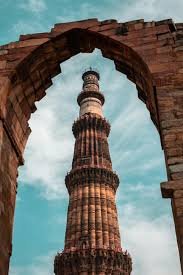One of the first structures of the Islamic architectural legacy, the Quṭb Mīnār stands tall in the midst of the sprawling Qutb complex. The best-preserved building of the complex, it may have been inspired by the minaret of Jām in Afghanistan.
The tower was probably commissioned by the first Muslim ruler of Delhi, Quṭb al-Dīn Aibak, although only the first tier was completed during his rule. (He died in 1210).

His successor, Iltumish, and thereafter Fīrūz Shah Tughluq, commissioned the subsequent tiers, raising its height to an astounding 238 feet (72.5 meters), making it the tallest brick masonry tower in the world. The diameter of the tower is 47 feet (14.3 meters) at the base, gradually tapering to less than 11.5 feet (3.5 meters) at the top. The tiers are multifaceted cylindrical shafts, with intricate carvings and verses, illustrative of the refinement and evolving craftsmanship of Islamic styles over the different ruling dynasties. Each of the five tiers is marked by a balcony supported by corbels.
There continues to be speculation about the purpose of the tower. Traditionally, all mosques had minarets to call people to prayer. Though the Quṭb Mīnār seems modeled on a similar style and it flanks the Qūwat-ul-Islām mosque, its scale supports the idea that it was envisaged as a victory tower, marking the overthrow of the Chauhan rulers of Delhi by Muḥammad of Ghūr.
The name Quṭb means “axis” and is believed to denote a new axis for Islamic dominion. Whatever the historical pedigree of the tower, it has stood the test of time and continues to be synonymous with the south Delhi skyline. (Bidisha Sinha)









